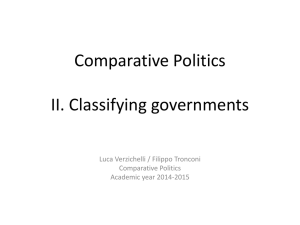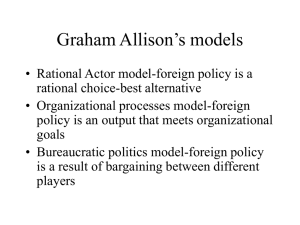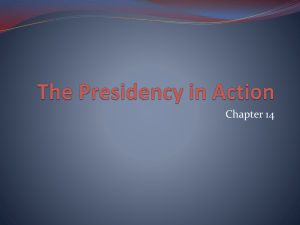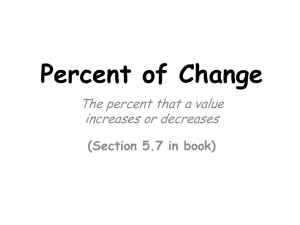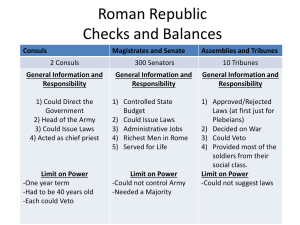class 7
advertisement
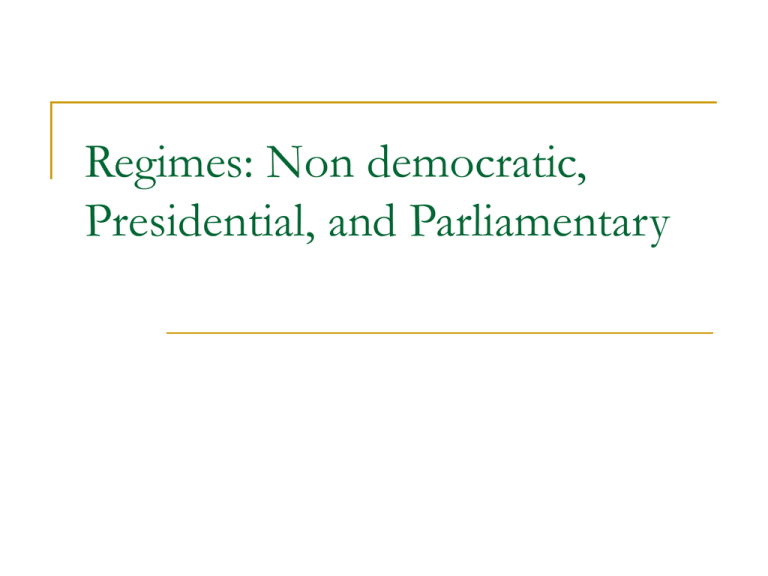
Regimes: Non democratic, Presidential, and Parliamentary Democracies and non democratic regimes Rousseau and the general interest ( against Arrow theorem results) Schumpeter: “The democratic method is that institutional arrangement for arriving at political decisions in which individuals acquire the power to decide by means of competitive struggle for the people’s vote”. Downs , Sartori and the effects of the competition Democracies and non democratic regimes Dahl (5 requirements for Democracy) : 1. Effective participation: Before a policy is adopted by the association, all he members must have equal and effective opportunities for making their views known to the other members as to what the policy should be Equality in voting:When the moment arrives at which the decision about policy will finally be made, every member must have an equal and effective opportunity to vote, and all votes must be counted as equal Gaining enlightened understanding: Within reasonable limits as to time, each member must have equal and effective opportunities for learning about the relevant alternative policies and their likely consequences Exercising control over the agenda: The members must have the exclusive opportunity to decide how and, if they choose, what matter are to be placed on the agenda Inclusion of adults: All, or at any rate most, adult permanent residents should have the full rights of citizens that are implied by the first four criteria 2. 3. 4. 5. Democracies and non democratic regimes Przeworski and the democratic stability: even if losers and winners were not determined by a competition but by a lottery, under certain conditions the losers in an “election” may prefer to wait until the next round rather than to revolt against the system . Presidentialim and Parliamentarism Stepan & Skach: A pure parliamentary regime in a democracy is a system of mutual dependence: 1. The chief executive power must be supported by a majority in the legislature and can fall if it receives a vote of no confidence. 2. The executive power (normally in conjunction with the head of state) has the capacity to dissolve the legislature and call for elections. A pure presidential regime in a democracy is a system of mutual independence: 1. The legislative power has a fixed electoral mandate that is its own source of legitimacy. 2. The chief executive power has a fixed electoral mandate that is its own source of legitimacy. Presidentialism, Parliamentarism and democratic stability 1. 2. Linz: “while parliamentarism imparts flexibility to the political process, Presidentialism makes it rather rigid” In the Parliamentarisms once elections are held either there is a majority party that forms the government, or the different parties enter into negotiations about government formation. The result of these negotiations is a government that is supported by parliament and anytime this support is undermined or challenged, a confidence vote resolves the issue. In presidential systems however, there is no mechanism for the resolution of conflicts between the executive and the legislative ““Replacing a president who has lost the confidence of his party or the people is an extremely difficult proposition. Even when polarization has intensified to the point of violence and illegality, a stubborn incumbent may remain in office. By the time the cumbersome mechanisms provided to dislodge him in favor of a more able and conciliatory successor have done their work, it may be too late.” Presidentialism, Parliamentarism ,democratic stability and other features Shugart & Carey: “strong presidential powers (both legislative and non-legislative) are more likely to lead to breakdown”.Regimes with legislatively strong presidents have one additional veto player, so policy stability increases. As a result of increased policy stability the regime may be unable to provide policy changes when needed, which may lead to breakdown. Strom:“parliamentary regimes may be better equipped to deal with problems of adverse selection… at the expense of another [problem], moral hazard” Diermeier & Federsen :”it is the confidence relationship, the threat of being voted out of office and losing agenda setting powers that makes parties more cohesive in parliamentary than in presidential systems; in fact interparty cohesion in parliamentary systems should be greater than intra party cohesion in presidential systems.” The Veto players Angle 1. 2. 3. 4. In order to understand the differences not only between democratic and non-democratic regimes, but also between presidentialism and parliamentarism, one has to focus on the process of law production: -How are veto players selected? -Who are the veto players? (who needs to agree for a change of the status quo)? -Who controls the legislative agenda? (who makes proposals to whom and under what rules)? -If these players are collective, under what rules does each one of them decide (simple majority, qualified majority, or unanimity)? Democratic and non democratic regimes: What distinguishes democratic fron nondemocratic regimes is whether the veto players are decided by competition between elites for vote or by some other process, and there is no necessary distinction in terms of representation or in terms of the actual number of veto players. Who are the veto players: Institutional veto players: individual or collective veto players who are specified by the constitution. The number of these veto players is expected to be constant but their properties may change. For example, they may be transformed from collective to individual (if one institution, deciding by simple majority, is controlled by a disciplined party) and vice versa. Also, their ideological distances may vary, and one or more of them may be absorbed. Partisan veto players: the veto players who are generated inside institutional veto players by the political game. For example, the replacement of a single party majority by a two party majority inside any institutional veto player transforms the situation from a single partisan veto player to two partisan veto players. Both the number and the properties of partisan veto players change over time. Parties may lose majorities, they may split, and they may merge and such transformations may have an effect on the number of partisan veto players. Who are the veto players: Institutional veto players: examples Eduskunta Bundestag e Bundesrat Camera e Senato House of Representatives, Senate, President State Lower Chamber Upper Chamber Bicameralism (Lijphart, 1999) Austria Nationalrat Bundesrat 2,0 Belgium Chambre des Représentants Sénat 3,0 Denmark Folketinget 1,0 Finland Eduskunta 1,0 France Assemblée nationale Sénat 3,0 Germany Bundestag Bundesrat 4,0 Greece Vouli Ton Ellinon 1,0 Iceland Althingi 1,0 Ireland Dáil Éireann Senate 2,0 Italy Camera Senato 3,0 Luxembourg Chambre des Députés Netherlands Tweede Kamer Norway Stortinget 1,5 Portugal Assembleia da Republica 1,0 Spain Congreso Sweden Riksdagen Switzerland Nationalrat Ständerat 4,0 UK House of Commons House of Lords 2,5 after 1953 after 1991 1,0 Eerste Kamer Senado 3,0 3,0 1,0 after 1970 Five party parliament in a unicameral parliamentary system. According to the constitution, legislation is enacted when a majority of this parliament agrees to replace the status quo. Assume that the five parties are cohesive and that any three of them control a majority. The situation specified by the constitution is a single institutional collective veto player. The status quo SQ we can identify the (majority) wincircle. This is the lightly shaded circular area in the figure. We can also identify the exact set of points that defeat SQ (the darker shaded area W(SQ)). Now consider that not all coalitions are possible but that three of the parties A, B, and C form a government. This alliance makes sure that none of them enters into coalitions with parties D or E. This additional information alters the number of partisan veto players as well as the expectations of the feasible solutions. The only points that can defeat SQ are located in the deeply shaded lens. Therefore, the new information transformed the analysis of the political system from one collective veto player to three individual ones and reduced the winset of the status quo. Steps to analyze specific political situations 1) we locate institutional veto players in a multidimensional space. 2) we proceed to disaggregate them into the partisan players they are composed of in order to identify the individual or collective veto players inside each one of them. 3) we apply the absorption rules to this system: if some of the veto players are located in the unanimity core of the others, we can eliminate them because they do not restrict the winset of the status quo. A new (not influential) veto player Since D is inside the core of A,B e C, the core does not increase, and the winset does not reduce B A D E C Same for E SQ These veto players are absorbed 15 Number and nature of the vetoplayers depend on : The constitutions the political circumstances the kind of law making under observation Examples 1. U.S. law making process 2. German Bundesrat role 3. French laws and French government decrees Who controls the legislative agenda? 1. 2. 1. 2. With respect to financial bills, the initiative belongs to the executive in both presidential and parliamentary systems. With respect to non financial bills however, as a general rule: In parliamentary systems the government makes a proposal to parliament to accept or reject. In presidential systems, parliament makes a proposal to the executive to accept or veto. the roles of agenda setting are reversed in the two systems. The names used for each one of these systems do not reflect the legislative reality: one expects presidents to be powerful in presidential systems, and parliaments in parliamentary. However: if parliament is strong in parliamentary systems it is not because of legislation; it is because it can withdraw its support from the government and replace it. If the president is strong in presidential systems it is not because of his power to legislate, but because of executive decrees and the power to make decisions on foreign policy and other matters. Who controls the legislative agenda? If the Government moves first GP as final outcome. If the Parliament moves first then PG as final outcome. SQ GP G PG P Who controls the legislative agenda? However the power of agenda setter does not nullify the role of other veto players… SQ G1 PG GP G PG1 P Wincircle Radius= d+2r winset yolk wincircle Cohesion of collective veto players Radius r of the yolk indicates the level of cohesion of the collective veto player – i.e. how much the majority is represented by the point Y As the wincircle grows with r : Conjecture : Policy stability increases as the m-cohesion of a collective veto player increases (as the radius of the yolk decreases) Veto Players cohesion in Presidentialism and Parliamentarism 1. 2. 3. Parties are more disciplined in parliamentary systems than in presidential ones, above all if the electoral system does not allow the preference vote. (open list) The internal cohesion of collective veto players affects the size of the area within which the winset is located. The lower the party cohesion, the lower is policy stability. Coeteris paribus presidential systems have lower policy stability. This is a very strong ceteris paribus clause because it is probably impossible to keep everything else equal. Effects of many veto players Differences in classifications between regimes, party systems, and veto players Parliamentary Democracy and Delegation (Strom) 1. 2. 3. Why Delegate? Capacity (time, transaction costs, namely costs in reaching, implementing and enforcing policy decisions ) Competence Social Choice and Collective Action problems (i.e. the problem of the Commons) The principal-agent framework 1. 2. 3. 1. 2. 3. Assumptions behind the model The Political Community is given and bounded The Preferences of principals and agents are exogenously given Principals face information scarcities and information is critical. Agents may “misbehave” in different ways: Policy divergence Leisure-shirking Rent seeking Political accountability 1. 2. 1. 2. a) b) c) An agent is accountable to his/her principal if He/She is obliged to act on her/his behalf He/She is empowered to reward or punish him/her for his/her performance Accountability implies that principals have to kind of rights: Right to demand information Capacity to impose sanctions Veto (or amend) power Deauthorize the agent Impose specific penalties Delegation and accountability under Presidentialism and Parlamentarism(ideal types) Ministry Head District Median voter Representatives Prime minister & Cabinet Ministry Head Delegation Accountability National Median voter State Median voter District Median voter President Secretary Civil Servant Civil Servant Civil Servant Civil Servant Civil Servant Civil Servant Civil Servant Civil Servant Civil Servant Upper house Secretary Lower house Civil Servant Civil Servant Civil Servant Features of a parliamentary democracy (Westminster ideal type) Indirect Delegation: few agents are directly elected by (and accountable to) the citizens Singularity: each principal employs a single agent. The length of the delegation chain and the impossibility to rely on agents to check one another (the singularity) increase the risks of agency loss. To counteract these dangers the Parliamentarim relies on the Party government, namely centralized, cohesive, policy oriented political parties Political Parties in the Parliamentary Chain of Delegation Political Parties: what are and under which conditions they work Political parties are complex collaborative devices for mutual gain, useful for both the candidates for public offices and for the voters. Two incentive conditions must be satisfied: 1. Parties have to provide sufficient inducements for political office holders to submit to the discipline (policy cohesion) they impose 2. This policy cohesion (discipline) must be sufficient for the voters to find party label informative and useful. Consequences of Partisanship (in the Westminster ideal type) 1. 2. Powerful device of ex ante screening pratically in each ring of the delegation chain. ..but ineffective ex post Oversight : Ex post accountability depends almost entirely on electoral competition and the election dates can be partially manipulated. Between elections accountability is tenuous mainly for the following reason: Parties strongly help the alignment of policy preferences along the chain of delegation. However such alignment means that members of the parliamentary majority have no meaningful incentive to scrutinize the behaviour of their fellow party members in the executive branch Parliamentary democracies different from the Westminster model Multiparty government can work differently from the ideal type of parliamentarism Also the type of party system dynamic makes the difference: Pivotal party system versus Alternational party system Even in the parlamentarisms is possible to find powerful institutional constraints Policy divergence under different regime types and preference configuration (Strom 2004) Parliamentary Democracy A1 Choose x 1 accept accept A2 P reject reject RP A=Agent P=Principal X RP (reverse point or status quo Collegial Presidential Democracy accept Delegate agenda A1 Choose x 1 accept A2 P reject reject RP RP P accept Delegate agenda X A2 Choose y 1 Y accept A1 P reject RP reject RP Competitive Presidential Democracy Delegate agenda A1 Choose x 1 P Delegate agenda X P A2 Choose y 1 Y RP The policy divergence in this complete information model represents the so called agency loss. This loss is measured as the distance between the outcome and the principal’s ideal point. Example A1 Parliamentary democracy: A1 propose 0P that is just marginally closer to P than 0. A2 accepts and also P. |P- | is the agency loss A2 0P P 0 or SQ or RP The different democratic regimes make the difference even when the preferences are located in the same manner A2 P A1 parl Parliamentary democracy: A1 propose its ideal point that is nearer to P and to A2 than 0. | P- parl. | is the agency loss 0 The different democratic regimes make the difference even when the preferences are located in the same manner A2 0A1 P pres.coll Collegial Presidentialism: P delegates agenda to A2.A2 proposes 0A1 that is just nearer to A1 than 0. | Ppres.coll| is the agency loss. | P-pres.coll|< | P- parl. | A1 0 Policy divergence (agency loss) under different Regime types Preference configuration Parl. system Competitiv Collegial e Presidenti Presidential al 1 0.67 0.33 0 A1 A2 P RP 0.32 0.32 0.32 A1 P A2 RP 0.02 0 0.02 A1 P RP A2 0.34 0 0.34 A1 RP A2 P 0.67 0.33 0.67 A1 RP P A2 0.34 0 0.34 A2 A1 P RP 0.32 0.32 0.32 A2 P A1 RP 0.34 0 0.02 A2 RP A1 P 0.67 0.33 0.67 P A1 A2 RP 0.35 0.33 0.33 P A2 A1 RP 0.67 0.33 0.35 General results from a comparison among different regimes (games) Parliamentary regime is susceptible to greater agency loss than either presidential model. Competitive presidentialism generally minimizes policy divergence; collegial presidentialism is in between. Other types of agency loss different from the policy divergence Leisure shirking Rent seeking (Bribe, useless regulation etc) Advantages and disadvantages of Parliamentary systems (ideal type) 1. 1. 2. 3. Pro: Efficiency (policy , administrative and incentive) Against: Lack of transparency Moral Hazard problems A singular chain of delegation is only strong as its weakest link Advantages and disadvantages of Presidential systems (ideal type) 1. 2. 3. 1. Pro: Transparency, (more ex post oversight) Stability in the outcomes More Learning (because of higher level of heterogeneity) Against: Lack of efficiency Regimes forms and agency loss Forms of Agency Loss Regime Form Policy Westiminster Parl. Divergence Leisure Shirking Rent Seeking Dominant Agency Problem High Low Moderately High Moral Hazard Pivotal Moderately Parliamentarism High Moderately High High Moral Hazard Constrained Moderate Parliamentarism Moderate Moderate Moral Hazard Collegial Presidentialism Moderately low High Low Adverse Selection Competitive Presdientialism Low Moderately Moderately low low Adverse Selection

